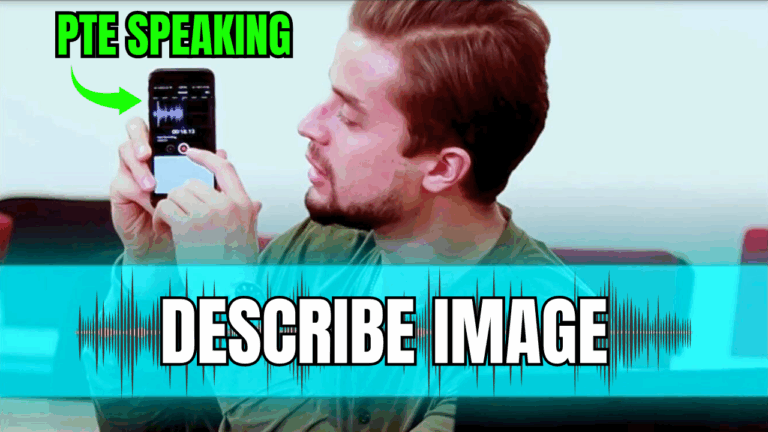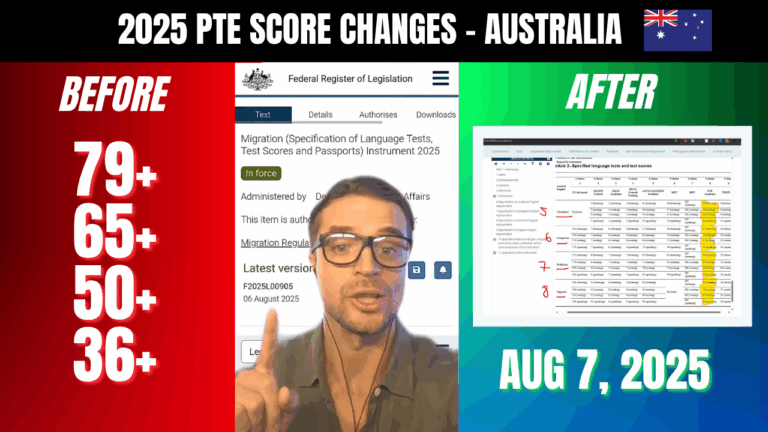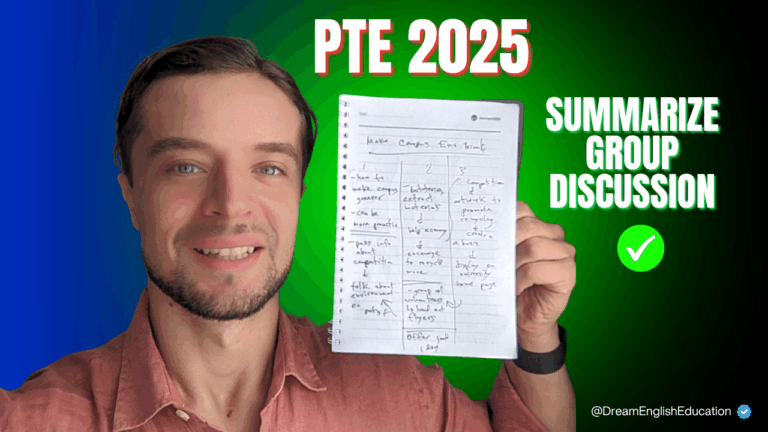PTE Listening Fill in the Blanks (5 MUST-KNOW rules & Free PDF)
What You Might Get Wrong in PTE Listening Fill in the Blanks
PTE Listening Fill in the Blanks is one of the most underestimated tasks in the entire PTE exam, yet it’s costing students massive points in both listening and writing scores.
In this article, we’re going to reveal the 5 CRITICAL Mistakes that literally every single person makes in this section – mistakes that are causing you to lose at least 4-5% in listening and another 4-5% in writing from this “simple” question alone.
We’ve seen students with perfect spelling still fail this task because they don’t understand the hidden rules that PTE uses to mark these questions.
PTE Listening Fill in the Blanks contributes to both your listening AND writing scores simultaneously. That means every mistake you make here hits you twice. Miss one word? You lose points in two different skill areas.
But don’t worry – by the end of this comprehensive guide, you’ll know exactly how to master PTE Listening Fill in the Blanks and turn this section into a score booster instead of a score killer.
Read till the very end to get our FREE Listening FIBs PDF! (with REAL exam words)

What is PTE Listening Fill in the Blanks? (The Complete 2025 Guide)
PTE Listening Fill in the Blanks is a task where you listen to an audio recording while reading a transcript that has several words missing. Your job is to type the missing words into the blanks as you hear them. Sounds simple, right? Wrong.
This task appears 2-3 times in your PTE exam, and each question typically has 4-7 blanks to fill. The audio is played only once, and you need to follow along with the transcript while simultaneously listening for the missing words and typing them correctly.
Here’s what makes PTE Listening Fill in the Blanks so tricky: it’s testing multiple skills at once. You need excellent listening comprehension, fast typing skills, perfect spelling, proper capitalization knowledge, and the ability to multitask under pressure. Miss any one of these elements, and you lose marks in both listening and writing.
The scoring system is particularly harsh – if you make ANY mistake (wrong spelling, incorrect capitalization, extra spaces, missing letters), you get zero points for that blank. No partial credit. No second chances.
Why Most Students Fail PTE Listening Fill in the Blanks (TRUE STORY)
Before I teach you the winning strategy, let me tell you why 90% of students are getting this wrong. The biggest mistake? They think it’s just about spelling. They assume that if they went to school for a long time and have decent spelling, they’ll automatically do well. This couldn’t be further from the truth.
I had a student – very intelligent guy, excellent English skills, but a little overconfident.
I told him:
“Do not type directly in the boxes. Follow with your finger, write it out by hand, then type it at the end.” What did he do? Ignored my advice completely.
After the exam, he calls me up:
“Mate, you know how you told me not to type in the boxes? Well, I did it anyway. I was typing directly and lost my spot. I hit tab to jump to the next box, but it didn’t work. I panicked, missed the last four words, and lost 8% of my total score – 4% in listening and 4% in writing.”
This is exactly why students fail PTE Listening Fill in the Blanks. They underestimate the technical challenges and focus only on the obvious skills while ignoring the hidden rules that can make or break their score.
The 5 Critical Mistakes Everyone Makes (And How to Fix Them)
Mistake #1: Not Knowing What to Capitalize
This is the number one reason students lose marks in PTE Listening Fill in the Blanks, and it’s completely preventable. Even if you get the right word with perfect spelling, if you forget to capitalize when you should (or capitalize when you shouldn’t), you get zero points for that blank.
Here’s what you MUST capitalize:
New Sentences: Always check if there’s a full stop at the end of the previous line. If there is, the next word must be capitalized, even if the blank appears at the beginning of a new line.
Proper Nouns: Countries (Australia, India), cities (Sydney, Mumbai), names (Alex, John), languages (English, French). These are non-negotiable.
Variable Words: This is where it gets tricky. Some words are capitalized sometimes but not others. Take the word “professor” – if I say “Mr. Smith is an excellent professor,” the ‘p’ is lowercase. But if I say “Today’s speaker is Professor Smith,” it must be capitalized because it’s used as a title with a name.
Here’s what you should NOT capitalize:
School Subjects: Math, geography, history, science – these are common nouns, not proper nouns. The only exception is language classes like “French class” or “English class.”
Common Nouns: Just because a word seems important doesn’t mean it gets capitalized.
The key is to quickly scan before and after the blank to see if there are names, places, or other context clues that indicate proper noun usage.
Mistake #2: Writing Two Words in One Blank
This is a fundamental rule that students constantly break: One word, one blank. Always.
Sometimes when you’re listening, it might sound like the speaker is saying two words, but PTE will never, ever put two separate words in one blank. If it sounds like two words, it means either:
1. The word is written as one word (like “everyday” when referring to routine)
2. The word is hyphenated (like “well-balanced”)
Let me give you an example. If the audio says “Your work and life has to be well-balanced,” and you hear “well balanced” in the blank, many students will write “well balanced” with a space. That’s wrong. The correct answer is “well-balanced” with a hyphen.
Other common examples:
• “Every day” (going to school every day) = two words, never appears in PTE blanks
• “Everyday” (your everyday routine) = one word, can appear in blanks
• “Self-confident” = hyphenated, one blank
• “Twenty-five” = hyphenated, one blank
The rule is absolute: if you hear what sounds like two words, look for the hyphenated or compound version.
Mistake #3: Leaving Blanks Empty
This is a catastrophic mistake that can destroy your entire score for the question. Here’s what our testing has revealed: when students leave even one blank empty, the PTE software often gives them zero for the entire question, even if they got all the other words correct.
Yes, you read that right. Get five words perfect, leave one blank empty, and you might get zero points for the whole question. This varies depending on the exam version, software update, and test center, but do you really want to take that risk?
If you miss a word completely, here’s what you should do:
Write anything: “Hello,” “right,” “test,” “word” – literally anything is better than leaving it empty.
Use context clues: If you kind of heard what the word sounds like (“parch,” “perch,” “patch”), quickly scan the text. Often, the same word appears elsewhere in the passage. I once had “perch” in my exam (talking about fish), but the accent made it sound like “purge” or “party.” I scanned the text, found “perching” later in the passage, and realized the missing word was “perch.”
Make an educated guess: If you heard a ‘p’ sound and it’s talking about fish, “perch” is more likely than “party.”
Never, ever leave a blank empty. It’s better to guess wrong than not to guess at all.
Mistake #4: Poor Time Management
PTE Listening Fill in the Blanks requires precise timing. Too fast, and you’ll make careless mistakes. Too slow, and you’ll run out of time for later questions.
Here’s the optimal timing strategy:
During the audio: Follow with your finger, write words by hand on your notepad. Don’t type anything yet.
After the audio ends: You have exactly 30 seconds to type your answers and check them. Not 45 seconds, not a minute – 30 seconds maximum.
10-15 seconds: Type all your handwritten words into the blanks
10-15 seconds: Quick grammar and spelling check
If you spend longer than 30 seconds, you’ll struggle to finish the dictation questions that come later, and you might fail your entire exam because of time management issues.
If you don’t check at all and just click “Next,” you’ll make countless spelling and capitalization mistakes that could have been easily caught.
Mistake #5: Typing Directly in the Boxes
This is the mistake that cost my student 8% of his total score, and I see it happening constantly. Students think they can save time by typing directly into the answer boxes while listening. This is a recipe for disaster.
Here’s what happens when you type directly:
• You lose your place in the audio
• You get distracted by spelling corrections
• The tab button might not work (software issues)
• You panic when things go wrong
• You miss multiple words while trying to fix one mistake
The correct approach:
1. Follow with your finger on the screen to keep your place
2. Write words by hand on your notepad as you hear them
3. Don’t lose your spot in the transcript
4. After the audio ends, spend 15-20 seconds typing everything properly
I know you might think your spelling is perfect and you don’t need to write things down, but even native English speakers make mistakes when multitasking under pressure.
Don’t let overconfidence cost you 8% of your score.
The Hidden Letters You’re Missing in PTE Listening FIB
Here’s the most important rule that most students never learn: PTE Listening Fill in the Blanks is primarily a grammar test disguised as a listening test.
Even native English speakers miss the endings of words (-s, -ed, -ing) because many accents don’t emphasize these sounds. British speakers often don’t pronounce the ‘r’ in “proper” – they say “propa.” Scottish and Irish accents can make past tense endings nearly inaudible.
But here’s the secret: grammar always wins over what you think you heard.
If the sentence structure requires past tense, the answer must be past tense, even if you didn’t clearly hear the “-ed” ending. If the grammar requires plural, the answer must be plural, even if you only heard the singular form.
Quick Grammar Check Method
After typing your answers, spend 10 seconds doing this grammar check:
Check for tense consistency: If the sentence is talking about the past, make sure your verbs are in past tense.
Check for subject-verb agreement: “The choice of classes” not “the choice of class” – if it’s “choice of,” it must be plural.
Check for logical word forms: “I am trying” not “I am try” – if you see “am,” the next verb needs “-ing.”
Look at surrounding words: Articles like “a” or “an” indicate singular nouns. Words like “many” or “several” indicate plurals.
This grammar check has saved countless students from losing easy marks. Remember: the number one priority in PTE is always grammar. Even if you didn’t hear the ending clearly, grammatically the answer has to be correct.
Advanced Strategies for Perfect Scores
The Finger-Following Technique
This is non-negotiable for PTE Listening Fill in the Blanks success. Your finger should be moving along the text as the audio plays, keeping you anchored to the right position. This prevents the most common disaster: losing your place and missing multiple consecutive words.
Practice this technique:
1. Start with your finger at the beginning of the text
2. Move it smoothly as the speaker reads
3. When you reach a blank, keep your finger there while you write the word
4. Immediately return to following the audio
The Notepad Strategy
Your notepad is your lifeline in PTE Listening Fill in the Blanks. Here’s how to use it effectively:
Write clearly: You need to be able to read your own handwriting quickly.
Don’t worry about running out of space, the exam notebook is erasable!
Use abbreviations: “govt” for government, “edu” for education
Mark difficult words: Put a star next to words you’re unsure about
Number your answers: Write “1. government, 2. education” etc. to match the blank order
The Context Scanning Method
When you’re unsure about a word, quickly scan the entire text for context clues:
• Look for the same word used elsewhere
• Check for related terms that might give you hints
• Notice the topic and think of likely vocabulary
• Use process of elimination if you have multiple possibilities
Common Words That Trip Everyone Up
Based on thousands of student experiences, here are the words that appear frequently in PTE Listening Fill in the Blanks and cause the most problems:
Spelling Nightmares:
• Necessary (not “neccessary”)
• Separate (not “seperate”)
• Definitely (not “definately”)
• Occurrence (not “occurence”)
• Maintenance (not “maintainence”)
Capitalization Traps:
• Internet (always capitalized)
• Government (lowercase unless referring to a specific government)
• University (lowercase unless part of a proper name like “Oxford University”)
Hyphenation Confusion:
• Well-known (always hyphenated when used as an adjective)
• Twenty-first (numbers from twenty-one to ninety-nine)
• Self-confident, self-aware, self-control (self- compounds)
Sound-Alike Problems:
• Accept vs. except
• Affect vs. effect
• Principal vs. principle
• Compliment vs. complement
Listening FIB Strategies That Actually Work
- Focus on the above-mentioned mistakes – before worrying about difficult vocabulary.
- Practice the finger-following technique with easy audio
- Work on notepad writing speed and clarity
- Master the 30-second typing and checking routine
- Now add the grammar checking component:
- Practice with various English accents (British, Australian, American)
AS PROMISED:
Here’s a list of FREE PTE Listening Fill in the Blanks Practice Words:
Ready to Master PTE Listening Fill in the Blanks?
Want to master every aspect of the PTE exam with methods that actually work?
Join our comprehensive PTE coaching program where we personally teach you all the strategies that have helped thousands of students achieve their target scores. No fluff, no theory – just practical methods that get results.
These PTE Listening Fill in the Blanks strategies are just the beginning. When you’re ready to take your PTE preparation to the next level and guarantee your success, we’re here to help you achieve your dreams.
The difference between students who struggle with PTE and those who excel isn’t talent or natural ability – it’s knowing the right strategies and applying them consistently.
Hope this helps, and good luck with your preparation!
Alex 🙂
👉 Learn the NEW 2025 Updates & Strategies – check our Online Coaching Packages
👉 For a FREE PTE Consultation – text our team on WhatsApp at: +61423058115
Subscribe to our YouTube for the LATEST Tips, Tricks & Strategies in PTE🙂
PS: Watch the video below on more PTE Listening FIB Strategies & Mistakes







